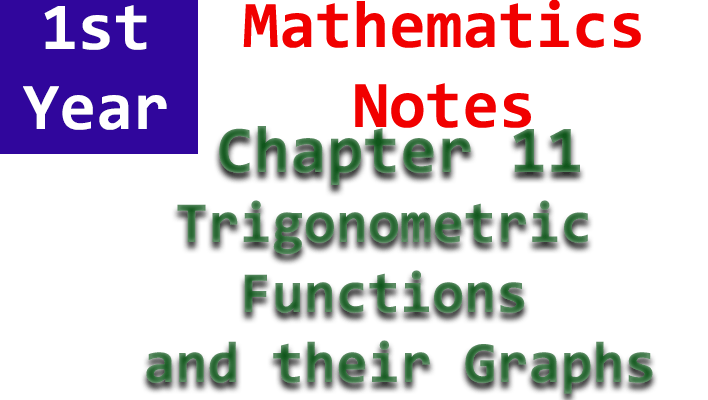Chapter 11 of your F.Sc 1st Year Math course, where we delve into the fascinating world of Trigonometric Functions and their Graphs. Trigonometry, often regarded as the study of triangles, plays a pivotal role in mathematics and science. In this chapter, we will explore the fundamental trigonometric functions, namely sine, cosine, and tangent, and their associated graphs. These functions are not only essential in solving real-world problems but also have profound applications in fields ranging from physics and engineering to computer science and astronomy.
By the end of this chapter, you will have a solid understanding of these functions, their graphical representations, and how they can be applied to model and analyze various phenomena. So, let’s embark on this mathematical journey to unravel the secrets of trigonometry and its graphical manifestations.
Before we delve into graphing trigonometric functions, it’s essential to first establish their domains and ranges. In Chapter 11 of our course, we’ve already introduced the core trigonometric functions: sine (sin), cosine (cos), tangent (tan), cosecant (csc), secant (sec), and cotangent (cot). These functions are defined in terms of the coordinates (x, y) of a point P(x, y) on the unit circle, where the angle ∠XOP = q is in standard position. From this definition, we ascertain that cos q = x and sin q = y, implying that for any real number q, there exists a unique value for cos q and sin q. Consequently, both sin q and cos q are functions of q, with domains spanning the set of real numbers (R).
Furthermore, since P(x, y) lies on the unit circle, it follows that -1 ≤ x ≤ 1 and -1 ≤ y ≤ 1. Thus, -1 ≤ cos q ≤ 1 and -1 ≤ sin q ≤ 1, leading to the conclusion that the range of both sine and cosine functions is [-1, 1].
In Chapter 11, we explore the domains and ranges of tangent (tan) and cotangent (cot) functions. These functions are defined with respect to the angle q, and from our geometric representation, we observe that the terminal side OP should not coincide with the Y-axis (OY or OY’). This condition leads to the exclusion of angles q equal to ±p, ±2p, and so on, where n is any integer. Consequently, the domain of the tangent function is expressed as {q | q ≠ (2n + 1)p, n ∈ Z}, covering all real numbers (R), while its range is also the set of real numbers (R).
Similarly, for the cotangent function, we establish that q should not equal 0, ±p, ±2p, and so forth, with n being an integer. Therefore, the domain of the cotangent function is R – {q | q = np, n ∈ Z}, and its range encompasses all real numbers (R).
Moving forward in Chapter 11, we tackle the domain and range of the secant (sec) function. Again, we observe that the terminal side OP should not coincide with the Y-axis (OY or OY’). By excluding angles q equal to ±p, ±2p, and so on, where n is any integer, we arrive at the domain of the secant function as {q | q ≠ (2n + 1)p, n ∈ Z}. As the secant function can assume all real values except those between -1 and 1, its range is expressed as R – {x | -1 < x < 1}.
Finally, in Chapter 11, we explore the domain and range of the cosecant (csc) function, which mirrors the behavior of the cotangent function. The domain of the cosecant function is given as R – {q | q = np, n ∈ Z}, and its range is R – {x | -1 < x < 1}, since it can take on all values except those between -1 and 1.
In summary, this chapter lay the foundation for understanding the domains and ranges of trigonometric functions, paving the way for a deeper exploration of their graphs.

